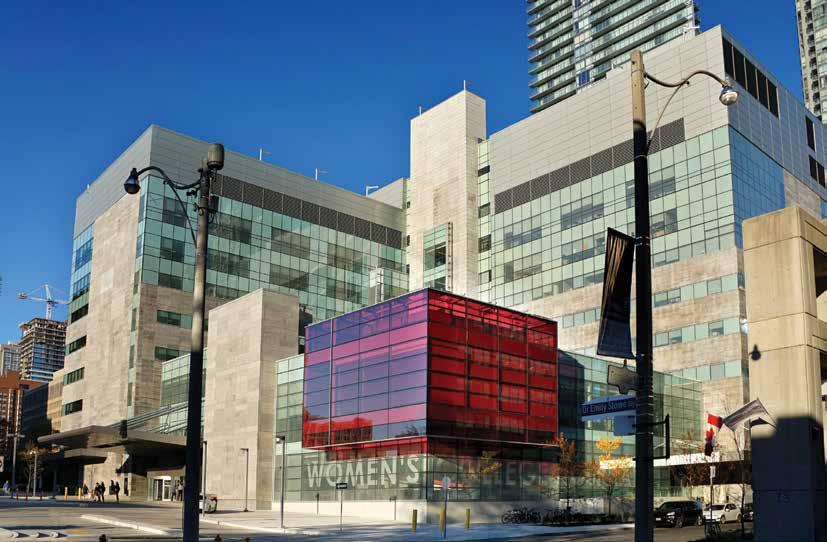
10 minute read
President’s Message
from CHF Summer 2020
by MediaEdge
EMBRACING THE NEW WORLD
I ALWAYS START the process of writing my president’s message by reading the previous one. Even though it has only been about four months, the spring issue seems like forever ago. The world today, personally and professionally, bares a stark resemblance to early March. But with many of us starting to see the light at the end of the tunnel and experiencing some relief from the chaotic days of April, we now have the opportunity to reflect on the last 90 days or so. Certainly, everyone has endured hardship trying to keep our respective facilities up to the COVID-19 challenge. However, just like the phoenix rising from the ashes, I’ve seen numerous examples across Canada of CHES members, both individually and collectively, successfully meeting these challenges. I’ve always believed you only see someone’s true colours when things go to hell in a handbasket. Well, I think we’re there and all of you have reaffirmed to me and shown those you work with that CHES members have the knowledge and right attitude to help our healthcare facilities navigate these COVID waters. Well done, everyone.
Advertisement
Despite all our efforts, we had no choice but to cancel all chapter conferences, including the 2020 CHES National Conference in Halifax this fall. These were tough (and disappointing) decisions. Fortunately, the financial fallout from the cancellations hasn’t been as bad as it could have been. From a CHES National perspective, our historically prudent monetary practices have set us up well to absorb this year’s cancellation with virtually no loss of services to members going forward. Work is already underway to rejig the next few national conferences in order to start planning for 2021.
Internationally, CHES’s plans to promote the 2022 International Federation of Healthcare Engineering (IFHE) Congress in Toronto at this year’s event in Rome fell through as it was postponed to 2021. This is only a minor setback; we have always believed heavy promotion of the 2022 congress would begin mid-2021.
On the positive side, there are a number of initiatives worth noting.
Based on a somewhat impromptu COVID ‘shared experiences’ webinar, there is growing interest in continuing with a series of touchpoint webinars so CHES members can share and learn from each other during the pandemic. Discussions are underway to flesh out what this might look like.
CSA medical gas training updates for both the general and ‘qualified operators’ courses are nearing completion. They are due for release this summer.
CHES wants to enhance its CSA presence by increasing formal representation on technical subcommittees. Specifically, CHES will solicit members to ensure someone sits on the subcommittee for CSA Z317.1, Special Requirements for Plumbing Installations in Health Care Facilities. This is a great opportunity for those looking to have an impact on the healthcare environment.
Look after yourself. Your families and facilities need you healthy.
Roger Holliss CHES National president
EARN CONTINUING EDUCATION CREDITS FROM CHES
Members of the Canadian Healthcare Engineering Society can earn free continuing education units (CEU) by reading the Summer 2020 issue of Canadian Healthcare Facilities and passing a quiz based on articles in the issue. Once you’ve read the issue from cover to cover, simply go online to www.surveymonkey.com/r/5Z7QHNG to take the quiz. CHES members who pass the quiz will be able to claim one contact hour (0.1 CEU) on their CanHCC or CCHFM certificate renewals.
the ART of BuildingT of Building Sustainability

CERTIFIED OPEN STANDARDS
Ensure a strong level of interoperability by using open protocols which have third-party listing laboratories to verify adherence to your protocol’s form and function. HVAC

Lighting
t h e A R T o f


B U I L D I N G S U S T A I N A B I L I T Y Security
SECURE DATA

Employ a single sign on (SSO) architecture with compliance to scalable credentialing architectures and secure tunneling methodologies such as BACnet virtual private networks (B/VPN).
INTEGRATED FAULT DETECTION & DIAGNOSTICS
Specify integrated FDD (IFDD) that delivers real-time fault detection, step-by-step root-cause diagnostics while using all your existing cabling structures, including twisted-pair networks.
OWNERSHIP OF ANALYTICS

Insist on timely analytics for all stakeholders with complete control of formatting and scheduling while retaining full ownership of your data and the reports generated. Select lifecycle-centric manufacturers who minimize the negative impacts of waste with long-term warranty and repair services while adhering to WEEE, RoHS and LEED directives.

Enjoy the long-term benefits of suppliers who engineer a path forward to new technologies while remaining backwards compatible without third-party gateways or hardware replacement.
Stay on top of regular advances in technology with supplier-certified, multi-lingual online educational videos, technical documentation, software updates, and advanced face-to-face classroom courses. MINIMAL WASTE
BACKWARD COMPATIBLE
OPERATOR TRAINING
SINGLE-APP EXPERIENCE
Create better-connected spaces with real-time access to occupancy, lighting, ventilation, and thermal comfort levels, using a holistic single app on the occupant’s mobile device.

Choose from a global network of factory-certified service partners who are passionate about long term, consistent, local support for you and your buildings. FACTORYCERTIFIED SERVICE
Sustainability requires a high level of integration between HVAC, lighting, and security systems. The art of building sustainability skillfully combines this integration with other technological and supporting elements that must endure over the long term. When these additional elements are maintained over the life of your building, true building sustainability emerges. To learn more about the ART of Building Sustainability please visit reliablecontrols.com/TABS3H20

A Whole New Standard of Care
Reinventing Toronto’s Women’s College Hospital
Founded in 1883, Women’s College Hospital is a leader in health for women, health equity and health system solutions. Today, the 630,000 square-foot LEED Gold building offers chronic disease management, surgical services, advanced image diagnostics, mental health programs, and more – all in a state-of-the-art complex that employs a leading-edge ambulatory model of care. Black & McDonald, a Canadian multitrade service provider specializing in high quality construction, facility services and technical solutions, has been a proud member of the Women’s College Hospital consortium since it was formed in 2010. The diverse team of experts was brought on to design, build, finance and maintain operations throughout the 30-year concession. For its part, Black & McDonald has delivered services in three key areas: Maintainability Consultation at the design phase; electrical, mechanical and network systems installation during the construction phase; and ongoing Facilities Management & Operations (FMO) throughout the 30-year concession.
“Since we began the contract, our primary focus has been to adopt a strong, co-operative approach to facilities management to ensure the hospital operates consistently at a high level,” says Stephen Jones, Senior Operations Manager, FMO, Black & McDonald. “The ongoing service excellence provided by our operations, maintenance and security staff has enabled Women’s College Hospital to continue to run effectively while it solidified its transformation into a world renowned ambulatory facility.”
PROJECT SCOPE & CHALLENGES
Envisioned around specialized operating suites and clinical zones that integrate treatment, research and education rather than prioritizing traditional in-patient wards, the new hospital is in a league of its own. With its iconic “Pink Cube” meeting room, light-filled atrium and bright open spaces, nothing about the facility feels outdated or institutional. But look beyond the contemporary aesthetics and what you’ll see is an ultra-modern facility driven by the best medical systems, processes and procedures available today.
Completed in two phases for a total cost of $460 million, the project began in 2008 and wrapped up in the fall of 2015. The first phase involved the construction of a clinical tower on the eastern half of the hospital site. The second phase saw the existing building demolished and a new administrative, research and education wing constructed on the site’s western half.
Don’t be fooled into thinking the process was straightforward; in reality it was anything but.
PROJECT DETAILS:
Location:
• Toronto, ON
Cost:
• $460 million
Projected savings (value for money):
• $86 million
Services provided by Black & McDonald:
• Electrical • Facility Management & Operations • Mechanical • Utility • Custom Fabrication
Outcomes:
• Modern ambulatory facility designed with specialized clinics and surgical suites that integrate prevention, disease management, treatment, research and education, providing better patient flow, technology and an improved patient experience • Increase in patient visits of more than 70 per cent annually • Improved energy efficiency • Superior operational standards
Jason Scott, Division Manager, FMO, Black & McDonald, is well aware of the complexities of undergoing healthcare retrofits. With five years to reflect on since the Women’s College Hospital project launched, success, he says, has a lot to do with preparedness: “Our proactive, hands-on approach to operations began long before the new facilities were commissioned. This early start enabled us to ensure a smooth transition for the clinical, maintenance and security staff moving to the new facility.”
That’s not to say there weren’t any challenges. From demolition dust and debris, to heavy vibrations felt during construction, numerous disturbances were at play. Early tactics to mitigate these factors involved engaging all stakeholders, hospital departments and clinical units about their functions, roles and responsibilities long before the transition began.
“Staff members were also provided the opportunity to acclimatize themselves with the new facility’s layout during the detailed phase planning meetings,” he says, adding that re-training existing maintenance and security staff was another top priority. “We spent ample time empowering them with the latest best practices to ensure they’d be successful from day one at the new facility. This was a significant endeavour considering the amount of services that needed to be consolidated and transitioned.”
SYSTEMS, SERVICES & THE PURSUIT OF SUSTAINABLE EXCELLENCE
As the hospital’s medical, maintenance and security staff underwent the transition, Black & McDonald’s mechanical and electrical teams had their own set of goals: To provide complete HVAC, plumbing, specialized medical systems, electrical equipment and various ongoing services to the new facility.
Informed by a comprehensive systems assessment and energy audit conducted in Phase 1, the team was able to identify key areas for improvement and subsequently work toward achieving efficiencies at the systems level.
Known for its commitment to excellence in service and customer care, Black & McDonald also strives to meet the highest standards of sustainability. With features ranging from green roof coverage and heat recovery system, to energy-efficient window glazing, the new Women’s College Hospital was designed to offer numerous community and green benefits. However, the pursuit of sustainable excellence didn’t end there.
“We continuously fine-tune various aspects of the hospital’s electrical and
WORKING IN MISSION-CRITICAL ENVIRONMENTS Black & McDonald understands the challenges of working within mission-critical environments of healthcare facilities undergoing extensive construction, renovation and maintenance work. As such, the team strives to minimize and whenever possible eliminate disruptions within the facility during shut-downs or tie-ins of new to existing systems. As was the case at Women’s College Hospital, a seamless transition with minimal disturbance to staff, patients and visitors is always the goal. Of equal importance, personnel are trained for Infection Control procedures when working in operational areas to reduce risk to healthcare staff, patients, and visitors. mechanical components as occupancy fluctuates throughout the clinical, diagnostic, office and retail spaces during the day,” says Abiola Adebayo, Energy & Sustainability Project Manager. “Our number one priority is to ensure we are putting our best foot forward in terms of energy conservation and sustainable operations.”
To that end, Black & McDonald has created a robust energy management plan, which breaks down and prioritizes implementation of energy conservation measures in phases, factoring in the significance of impact, cost of implementation, and the critical nature of the space in consideration.
“Additionally, we benchmark our energy performance on a regular basis with other comparable healthcare institutions in terms of Energy Usage Intensity (EUI), while adjusting for other parameters unique to each healthcare facility,” Abiola explains. “This helps us quantify how much room for further improvements we have. We are deeply committed to reducing our overarching carbon footprint and achieving our targets, and the success we’ve had thus far wouldn’t be possible without the efforts and commitment of our Operations teams and input from our stakeholders at the hospital.”
With 2020 marking the fifth year since the hospital’s reopening, it’s safe to say the redevelopment project is considered a success by all. From the specialized hospital systems installed and managed by the mechanical team, to the seamless transition of employees at start-up, the ambitious goals set by Black & McDonald will continue to guide the way forward, and contribute to the ongoing legacy of this remarkable facility.
Visit www.blackandmcdonald.com for more information.







